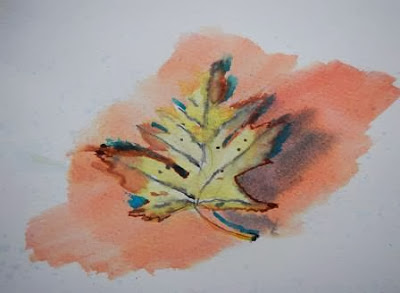About Me

- Diane Widler Wenzel
- Documenting a period in my development that could become pivotal
Thursday, November 21, 2013
Tuesday, November 12, 2013
Sunday, November 03, 2013
Watercolor Demonstrations for November 2, Fall Creek Festival
On the top painting, I looked for the main directions on a complex piece of drift wood and thought of how I would place it on the entire rectangular space. Then the drawing was quick roughing in a generality of the gestural directions of the wood. Then with a big puddle of color made on a palette, I filled the negative space around the drift wood. Next I put in some more pencil lines trying to define the borders of the high light areas, the mid tones and the darks. After mixing several grayed down colors on the palette, I painted the values leaving the lightest light the white of the paper with the little speckles of neutral colors from the conditioning of the paper before the painting was started. Last I put a shadow under the drift wood and when some of the paint was used up, I warmed up the gray with a small amount of brown and added a few brushed lines to indicate the grain.
Less finished is the second painting started with defining the values of the wood itself. Then when that dried I put in the surrounding negative area. I did not finish the picture because the value changes in the wood are not strong enough considering the darkness of the background.
So obviously I am a better judge of how the painting is evolving if I paint the negative areas first. But of course experienced watercolorists can have their own process of painting suited to their expressive style.
The confession of a Oregon Hatchery Research Center, Fall Creek Festival watercolor workshop teacher
Yesterday I stole this painting from a morning workshop student. It was an accident that I stuffed it in my bag with my demos. And I feel very bad about taking it because I promised to leave it out for him after my class. He cared about it so much that he wanted to take it right after lunch, but was OK with me using it as a demonstration. I am sorry I am not good at remembering names so if anyone knowing him sees this post please have him call me so I can return it with big apologies.
The stolen painting is a good example of what I was teaching - beginning a painting by marring the surface slightly by splattering a dilute neutral color and letting it dry.
The purpose of splattering the paper are four. First, slightly damaging the perfect machine made paper could help free a person from having to feel their work must be perfect. Second, leaving the objects almost pure white, while painting all around the object outline, the painter has an immediate feel for the whole picture plane without obsessing with the details of the object. Of course painting the negative area is not the only way to start a painting: I intend this beginning only for people who have not painted with watercolor. Third, the splattered white has a finished feel inside the object as soon as there is a good deal of color shapes in the picture. A slightly sullied white is a better reference than the unfinished look of unpainted paper. The splattered empty of detail is helpful for deciding where the lightest lights will be. Fourth, splattered or marred paper is helpful in adjusting the medium darks and darkest darks in relation to the lightest highlights in a watercolor painting.
If all else fails maybe next year, the stolen painting will be at the workshop and hopefully the wronged student will be back and will be able to claim it.
Subscribe to:
Posts (Atom)









